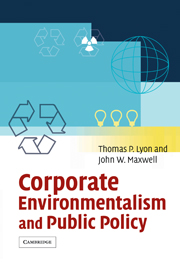Book contents
- Frontmatter
- Contents
- Preface
- Part I The interaction of strategy and policy
- Part II Corporate strategy and the policy life cycle
- Part III Government voluntary programs
- 6 An institutional analysis of voluntary environmental agreements
- 7 Negotiated agreements
- 8 Self-regulation, taxation, and public voluntary agreements
- 9 The design of public voluntary agreements
- 10 Conclusions
- References
- Index
8 - Self-regulation, taxation, and public voluntary agreements
Published online by Cambridge University Press: 10 December 2009
- Frontmatter
- Contents
- Preface
- Part I The interaction of strategy and policy
- Part II Corporate strategy and the policy life cycle
- Part III Government voluntary programs
- 6 An institutional analysis of voluntary environmental agreements
- 7 Negotiated agreements
- 8 Self-regulation, taxation, and public voluntary agreements
- 9 The design of public voluntary agreements
- 10 Conclusions
- References
- Index
Summary
INTRODUCTION
Chapter 6 explained how regulators benefit from the use of voluntary agreements (VAs), and chapter 7 showed how negotiated agreements (NAs) – used frequently in Europe and Japan – can serve the interests of both industry and regulators. In this chapter, we turn to public voluntary agreements (PVAs), which are commonly used in the USA. Under PVAs, participating firms agree to make good faith efforts to meet program goals established by the regulatory agency; in return, they may receive technical assistance and/or favorable publicity from the government. The present chapter is based on Lyon and Maxwell (2003a) and develops a model of corporate and government behavior in which self-regulation, taxation, and PVAs can be considered in one unified framework. In so doing, we sharpen the discussion of VAs by distinguishing carefully the relative merits of each of these instruments.
As we showed in chapter 3, the preemption of stricter future regulations is a leading motivation for self-regulation. This motivation can also explain corporate participation in voluntary environmental agreements between corporations and environmental regulators, as discussed in chapter 7. Furthermore, chapter 6 showed that the environmental regulator may wish to preempt future regulations if voluntary actions represent a cheaper way of achieving environmental goals. While preemption may indeed explain the adoption of some VAs, it is not uncommon to find PVAs in the absence of strong regulatory threats. In fact the US EPA notes that “Governments promote voluntary initiatives for a variety of reasons, including the pilot testing of new approaches and the absence of legislative authority to establish mandatory programs” (US EPA 2001, p. 173; emphasis added).
- Type
- Chapter
- Information
- Corporate Environmentalism and Public Policy , pp. 195 - 227Publisher: Cambridge University PressPrint publication year: 2004

